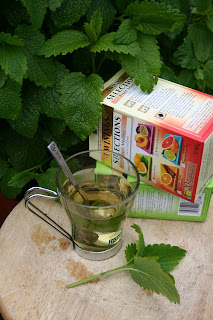
I went shopping last week for some herb teas. We were having some friends and family around and thought they would be grateful of an alternative to tea and coffee. I bought some of the “natures equivalent” ones which means that they are pumped full of chemicals. I forgot that I wrote to the manufacturers a few years ago to ask them what the chemicals were that made up the teas. I was amazed when the company sent me a fifteen page run down on chemical names. I think they thought that they could blind me with science, and they were right! These drinks are tangy and refreshing but not to everyone’s taste. There are chemical free alternatives to the fruity bought varieties –any herbal teas such as camomile or mint is fine. Alternatively, grow your own plants in the garden and either pick them as required or freeze and/or dry them for herbal tisanes when they are out of season.
Teas from the garden include fennel, mint, rosemary and one of our favourites - the lemon balm. As far back as the ancient Greeks this plant was recognised for both its soothing smell and its medicinal properties. Like most herbs lemon balm is antibacterial and anti viral in nature. It is also a slightly sedative herb, lowering fever, relaxing spasms and improving digestion. We just drink it because a few leaves soaked in boiling water tastes very refreshing. Taking drinks other than ones that contain tannin and caffeine such as tea and coffee makes for a pleasant change. Other plants that yield pleasing drinks are:
Thyme - pull some leaves off the stalk and infuse (see below). Good for easing congestion and may be used to ward off colds.
Ginger - cut three or four slices of peeled, fresh root ginger. Chop one teaspoon finely, then infuse. Improves circulation and relieves sore throats.
Feverfew - select two or three small leaves and chop or shred and infuse. Reduces fevers and eases migraine.
Garlic - chop one clove finely and infuse. Its antiviral and antibacterial properties help to ward off infection. It also improves circulation and can benefit the cardiovascular system.
Peppermint - chop or shred three to four peppermint leaves and infuse. Aids digestion and freshens breath.
Valerian - chop or shred four to five fresh leaves and infuse as above. Has a relaxing effect and eases anxiety and insomnia.
Parsley - select three to four small heads of fresh parsley, chop finely and infuse. This herb is rich in minerals and naturally diuretic, so relieves water retention.
Nettle - take three to four young leaves (use gloves when picking) chop and infuse. Nettle is rich in trace elements and minerals, and promotes healthy nails, skin, hair and bones. It also has a diuretic effect.
Chamomile -Relaxes nerves and mild sedative
Be aware that some of the plants can be very powerful and if you are on medication or pregnant then check with your doctor first
MAKING THE DRINKS
We tend to just throw a few leaves into a cup and pour on boiling water. If you want to infuse the ingredients by the book here are the recommendations, it’s a bit like making a pot of your favourite tea.
1. Select an appropriate herb. Organic (pesticide-free) ones are best. Those from gardens, hedgerows or window boxes are fine if they haven't been exposed to car fumes.
2. Pick the leaves and chop finely or shred by hand.
3. Place one to two heaped teaspoons in a china cup and fill it with freshly boiled water.
4. Leave to infuse for five minutes, then drink slowly.
You can add a teaspoon of honey as a sweetener, if desired
There are green teas on the market if you still need the caffeine hit. Green tea is said to help arthritis sufferers and could eradicate allergies. They are also claimed to improve the memory.
Horticultural-Environmental
No comments:
Post a Comment